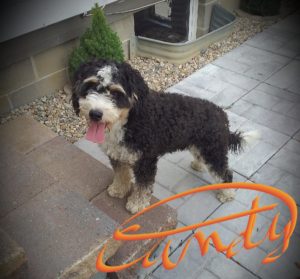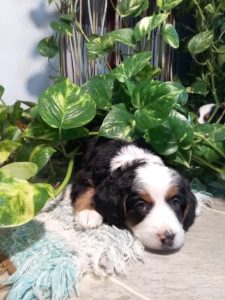About bernedoodles
mini bernedoodle for sale california
bernedoodle for sale
perfect companion dog
They are the result of a cross between a Standard, miniature or toy Poodle with a Bernese Mountain Dog. With the miniature and the toy Poodle being the males. The Poodle breed is low-shedding and low-dander characteristics which is great for people with allergies. Other characteristics attributable to the Poodle and the Bernese is their loyalty, high intelligence factor, very affectionate along with their personal character and charisma. They are outstanding family dogs who have proven to be great with children and other pets. Many make great service dogs.
No two Bernedoodles are identical. The genes from the parent breeds meld in unique ways, and it’s interesting and fascinating to see what each litter produces.
The Bernedoodle is the perfect companion dog. They are intelligent, very social and fun, crossbreed with character and charisma with a moderate activity level. They love being at your side no matter whether you are hiking, swimming, snowshoeing, or when its time to relax they can’t wait to snuggling with you on the couch. They may inherit the Poodle’s love for retrieving and swimming. Their main focus is to be your best friend and companion.
Bernedoodles are usually pure black, black-and-white, black-and-brown, or tri-color (black, white and brown), we have seen other colors. Their overall appearance combines elements of the Bernese and the Poodle. Beyond color, well selected parents tend to blend the traits of the Poodle and the Berner in a more consistent way. Although some pups may lean more toward the Poodle’s slighter build, or the Berner’s stockiness, there is a common “look,” and a breeder can, to some extent, control that by studying the results of matching up the parents. In short, Bernedoodles tend to look like shaggy teddy bears!
Many clients want a tri-color Bernedoodle, with markings as similar as possible to those of the Bernese Mountain Dog. That look is challenging to achieve, and people may have a long wait for it. Personally, I love Bernedoodles of all colors. Temperament is far more important to me than color.
Life Span…. By crossing the Bernese with the Poodle, it creates a healthier, happier dog with the desired hybrid vigor that greatly decreases the chances of them inheriting any “breed related” health issues.
However we have been breeding purebred Bernese mountain dogs for many years. We take it very seriously when it comes to health and longevity of life. We breed for longevity of life, Healthy hips and elbows. We have been very fortunate when it comes to hips and elbobows. Our dogs have also been cancer free. We have not experienced any of those issues with-in our line of dogs as of yet.
Average life span for a Bernese Mountain dog is 7 to 9 years of age. However approx 80% of our dogs and ancestors are enjoying life spans from 10 to 13 years of age.
The average lifespan expectancy of a Bernedoodle is 12-15 yrs.
Coat: The majority of Bernedoodles have a wavy coat that sheds minimally, if at all. Most people with allergies to dog dander (i.e., those who experience sneezing and runny eyes) are fine with a wavy-coated Bernedoodle.
Bernedoodles with a curly coat are similar to the Poodle and will not shed. While there are no guarantees, even if you have serious allergies to dander, you should be fine a curly-coated Bernedoodle.
If you are allergic to dog saliva, and your skin breaks out in hives when licked by a dog, you will most likely be allergic to all Bernedoodles regardless of coat type.
As for grooming, the curlier the dog’s coat is more challenging to maintain. Since most Bernedoodles shed little, if at all, they need to be brushed on a regular bases to prevent matting, and must be clipped every few months.
bernese mountain dog
Sizes: Bernedoodles come in a variety of different sizes, depending on the parents and their genetics. Females are usually smaller than males.
Standard Bernedoodle – Standard Poodle crossed with a Bernese Mountain Dog, will generally weigh 55-95 lbs. and around 22-30 inches at the shoulder
Mini Bernedoodle – Miniature Poodle crossed with a Bernese Mountain Dog, will generally weigh from 24-40 lbs. and is around 13-18 inches at the shoulder.
Tiny Bernedoodle – Toy Poodle crossed with a Mini Bernedoodle, will generally weigh from 9-23 lbs. and is about 11-16 inches at the shoulder.
These ranges cover the averages, however sometimes a puppy will fall outside these expected height and weights.
In terms of temperament, Mini and Tiny Bernedoodles may have a slightly higher energy levels than the standard, to reflect the same in the Miniature and Toy Poodle parent. However, using calm poodles, regardless of size, tends to produce docile Bernedoodles.
Training, Grooming and Caring for your Bernedoodle
Training: Bernedoodles thrive being around people and love attention. They may tend to stay immature for a bit longer and can be a bit stubborn during the puppy stage. With patience, proper training and positive reinforcement, the Bernedoodle will probably mature to be the best, lifelong companion dog you will ever own. It is very helpful to go to beginner puppy classes to help with the training process. You may visit your local dog training facilities in your area, and check out their customer reviews online. Any reputable and professional trainer will be able to answer any questions you may have concerning their training experience and provide you with customer references. Grooming….. Moderate grooming is essential to keep your Bernedoodle’s coat in nice condition. If you desire to keep the long natural look of your Bernedoodle’s coat, we suggest brushing 2-3 times weekly to keep the coat from matting. For lower maintenance, you may clip your Bernedoodle’s coat back 3-4 times a year.
It is a good idea to find a groomer that has experience grooming Poodle crosses such as the Goldendoodle or Labradoodle. You may also find pictures online of a groomed Doodle that you like and show that to your groomer for a guideline. Most reputable groomers will have photos or examples of past Doodles they can share with you that they have personally groomed. No one likes a bad hair day.
But if you have the time and enthusiasm, I predict your Bernedoodle will become the best friend you ever had—at least of the canine variety.
When purchasing a Bernedoodle puppy it is essential to be aware of all characteristics of both breeds in this cross. Looking for a puppy to bring into your family is an exciting process, but having the knowledge of what to expect with any dog is the key to successful integration into your family. A puppy is a huge commitment, so being knowledgeable about how to train and care for your Bernedoodle puppy is particularly valuable.
Thank you for taking the time to learn about the Bernedoodle. You can take a look at our Puppies page to view our Bernedoodle Puppies for Sale!
Tips on potty training your puppy
Every dog owner knows trying to potty train a puppy is no easy task. There are many factors that play into successful potty training, such as feeding schedules, rewards, and one of the most important things, setting a pattern. In the video above Shelley and Helen share helpful products and few tips on how to potty train a puppy.
Setting a Pattern
Setting a schedule is probably one of the most important steps you need to take in order to properly potty train a puppy. Setting a schedule will help your puppy learn when it’s time to eat, sleep, play and eliminate.
We all know puppy bladders are hard to control, so having a schedule will help you better plan out bathroom breaks. For the most part, a puppy can hold his bladder for about one hour for every month he is old. So, a two-month-old puppy can hold it in for about two hours. If you wait any longer than that, you’re asking for an accident. If you work outside the home, be sure to arrange for someone to give your puppy his breaks.
Motivate Him with Fun
There’s nothing better than a yummy treat to motivate a puppy to do something. Using treats and praise helps when potty training a puppy. After he has finished, reward him with praise, a treat, a long walk or playtime. Remember to do this consistently and immediately after he’s finished and when you are still outdoors. This step is very important because it’s the only way he’ll know what you expect.
Make sure he is finished before you reward him. Praising him too soon may excite him enough to stop in the middle of his business and then complete the job when he’s back in the house.
Accidents Happen
Like any small creature, accidents can happen. It’s a normal part of training a puppy. If you catch him in the act of soiling in the house, say “OUTSIDE” and immediately grab the leash and take him to his favorite potty spot. After he finishes, praise him and give him a treat, but only if he finishes outside.
To help prevent accidents inside you will have to clean the area really well and use an odor eliminator to keep your puppy from soiling in that same area.
Paper Training
If you must leave your puppy alone for long periods of time, confine him to an area with enough room to sleep and play, along with a separate place to eliminate. Use training pads with a floor protector in this area for your convenience.



